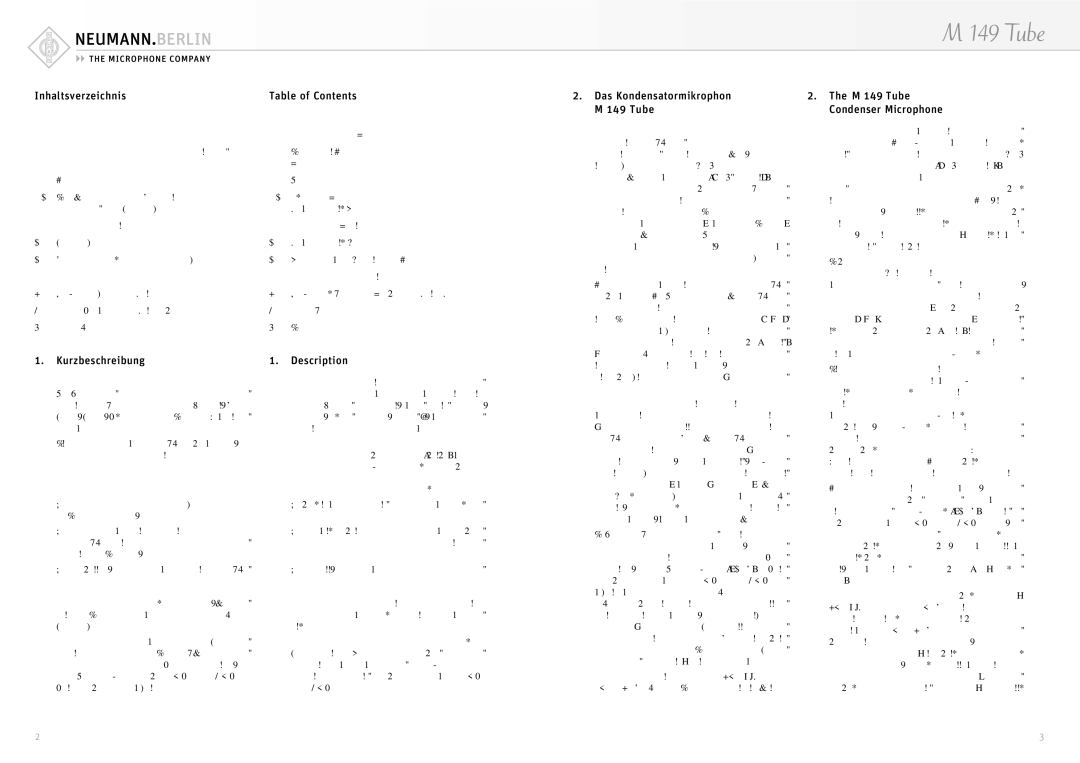
M 149 Tube
Inhaltsverzeichnis | Table of Contents |
1. Kurzbeschreibung | 1. Description |
2. Das Kondensatormikrophon | 2. The M 149 Tube |
M 149 Tube | Condenser Microphone |
2. | Das Kondensatormikrophon M 149 Tube | 2. | The M 149 Tube Condenser Microphone |
2.1 | Einige Zusatzinformationen zur Schaltungs- | 2.1 | Additional Information on the M 149 Tube |
| technik im M 149 Tube |
| Circuit Design |
2.2 | Inbetriebnahme | 2.2 | Getting Started |
2.3 | Ausführungsform und Beschaltung des | 2.3 | Type and Configuration of the Microphone and |
| Mikrophon- und Netzgeräteausgangs |
| Power Supply Outputs |
2.4 | Mikrophonkabel | 2.4 | Microphone Cables |
3. | Netzgerät | 3. | Power Supply Unit |
3.1 | Betrieb an unsymmetrischen Eingängen | 3.1 | Operation with Unbalanced Inputs |
4. | Technische Daten M 149 Tube | 4. | M 149 Tube Technical Specifications |
5. | Frequenzgänge und Polardiagramme | 5. | Frequency Response Curves and Polar Pattern |
6. | Einige Hinweise zur Pflege von Mikrophonen | 6. | Some Remarks on Microphone Maintenance |
7. | Zubehör | 7. | Accessories |
1. | Kurzbeschreibung | 1. | Description |
Das Kondensatormikrophon M 149 Tube ist ein umschaltbares
Im M 149 Tube wird als Eingangsstufe eine Röh- re verwendet. Im Gegensatz zu früheren Röhren- mikrophonen folgt dann aber eine transformator- lose Ausgangsschaltung. Dieses in den „TLM“- Mikrophonen bewährte Schaltungskonzept ist be- sonders unempfindlich gegen kapazitive
The M 149 Tube is a switchable pattern condens- er microphone. It is equipped with the legendary
A vacuum tube is used as the input stage of the M 149 Tube. Unlike earlier tube microphones which needed a
Das Kondensatormikrophon M 149 Tube ist ein
Als Eingangsstufe wird eine Röhre verwendet, um deren charakteristische Klangeigenschaften zu nutzen.
Das M 149 Tube zeichnet sich aus durch
•besonders niedriges Eigengeräusch und hohe Aussteuerbarkeit,
•ein neu entwickeltes Schaltungskonzept mit einer Röhre als Eingangsstufe und transforma- torlosem Ausgang,
•den vollen, reichen und warmen Klang des Röh- renmikrophons.
Das Mikrophon hat einen symmetrischen, übertrag- erlosen Ausgang und wird aus dem zugehörigen Netzgerät gespeist.
Die Einsprechrichtung wird durch das Neumann- Emblem gekennzeichnet. Auf der Rückseite befin- det sich ein siebenstufiger Hochpassschalter, mit dem Grenzfrequenzen von 20 Hz bis 160 Hz in Halboktavschritten wählbar sind.
The M 149 Tube is a large diaphragm studio con- denser microphone with nine switchable polar patterns:
The input stage is a vacuum tube (valve) with the sound properties unique to this type of device.
The M 149 Tube is characterized by
•very low inherent
•a newly developed circuit design with a vacu- um tube input stage and a transformerless out- put stage
•the full, rich and warm sound of a tube micro- phone.
The microphone has a balanced transformerless output and is powered by the included power sup- ply unit.
The front of the microphone is designated by the Neumann logo. On the back is a
Klangverfälschungen im oberen Übertragungsbe- reich kommt.
Durch die transformatorlose Schaltungstechnik wird der Klang auch im unteren und mittleren Übertragungsbereich allein durch die Kapsel und die Röhre bestimmt. Bei früheren Röhrenmikro- phonen beeinflusste dagegen auch der Übertrager den Klangcharakter, und zwar
Außer dem
Das M 149 Tube liefert mit ca. 50 mV/Pa einen 10 ... 15 dB höheren Ausgangspegel als übliche
Also due to the transformerless circuit design the sound of the medium and lower frequencies is en- tirely determined by the capsule and the tube. Earlier tube microphones used a transformer which affected the sound quality depending on the volume, the frequency and the load. The trans- formerless circuit design of the M 149 Tube pro- vides a very good common mode rejection factor just like a transformer. It effectively attenuates signals influencing the balanced audio signal.
In addition to the polar pattern switch, the micro- phone features a
The M 149 Tube has a sensitivity of approx. 50 mV/Pa. Due to the 10 dB amplification of the capsule signal by the tube it delivers an output signal which is 10 ... 15 dB higher than that of con- ventional studio microphones. Thus, the sound of the M 149 Tube is exclusively determined by these components, not by the following filter and output stage. Despite the microphone‘s high sen- sitivity its inherent
2 | 3 |
